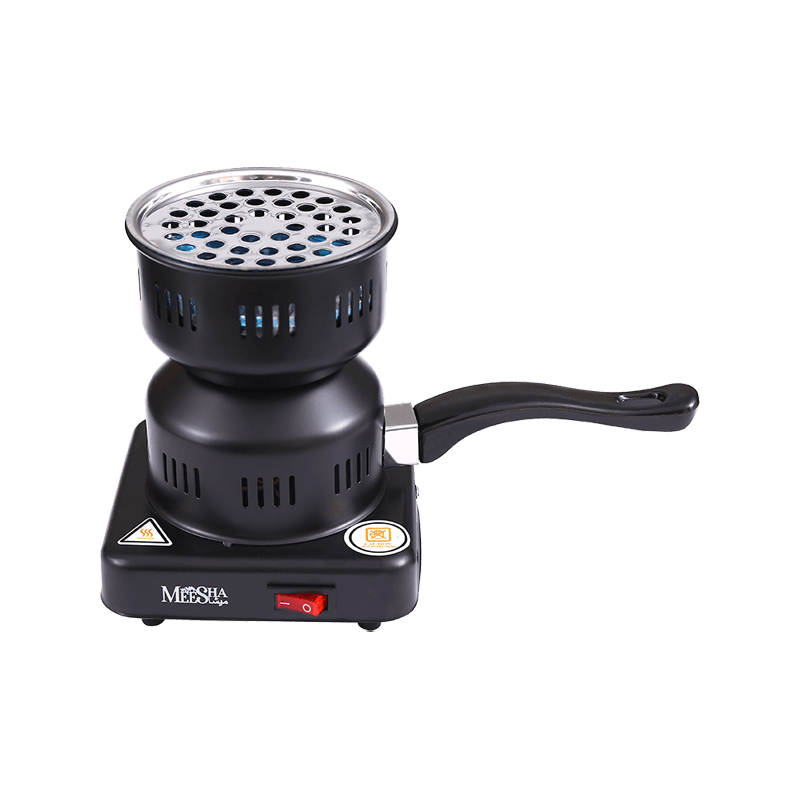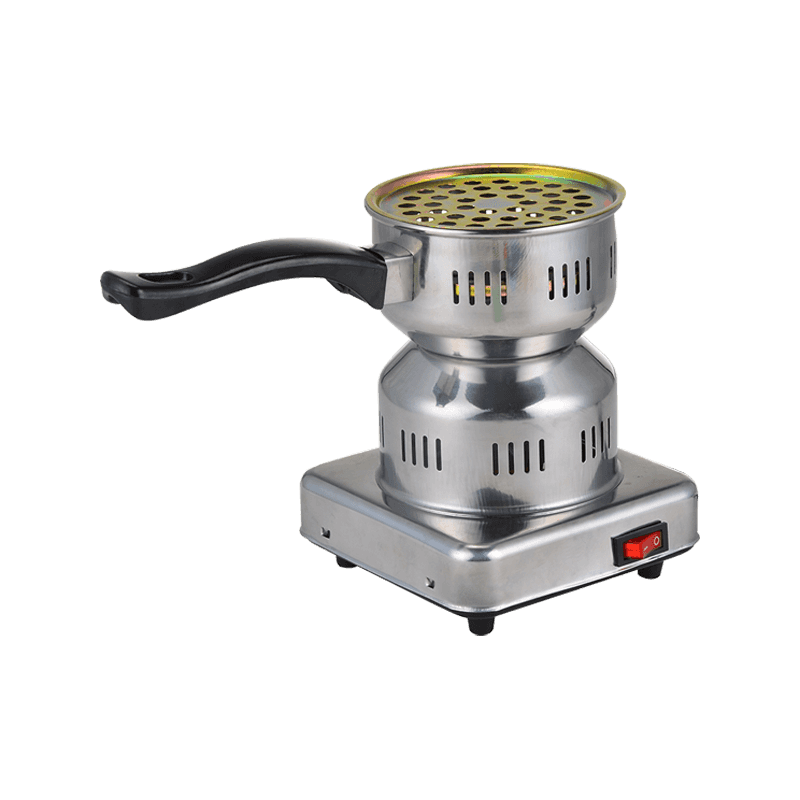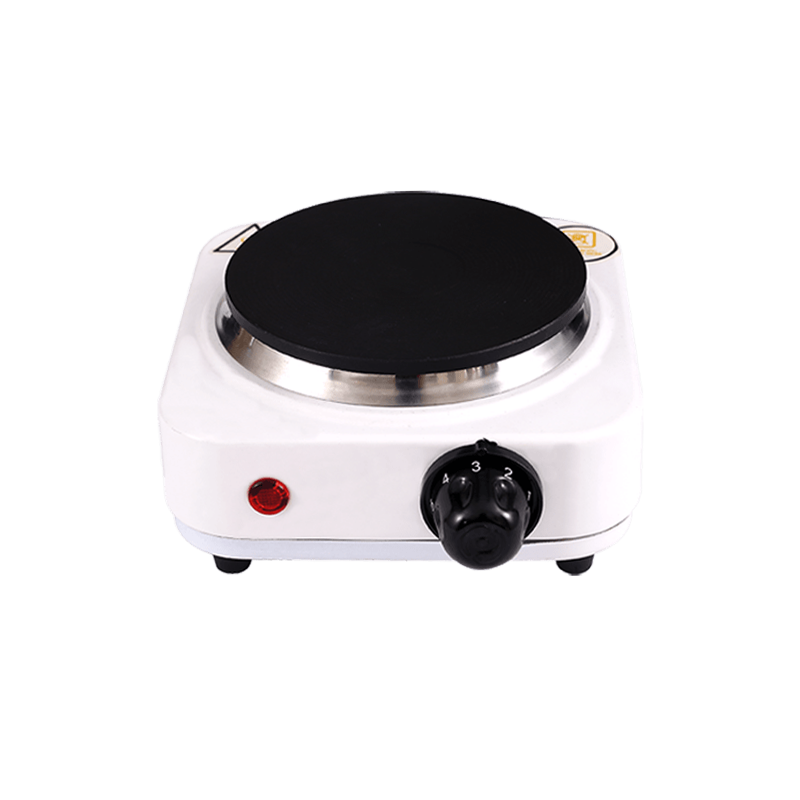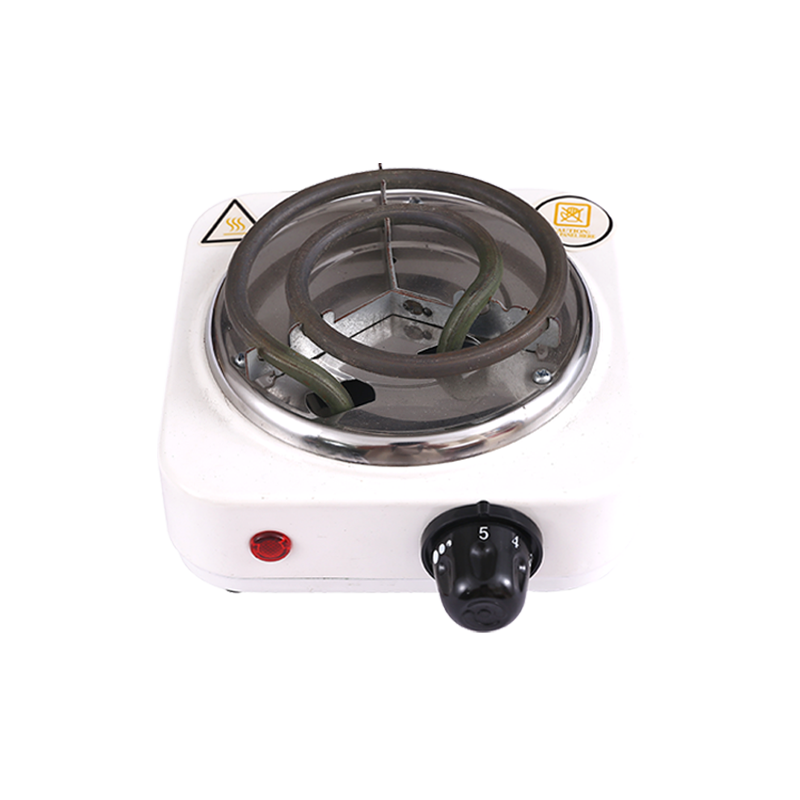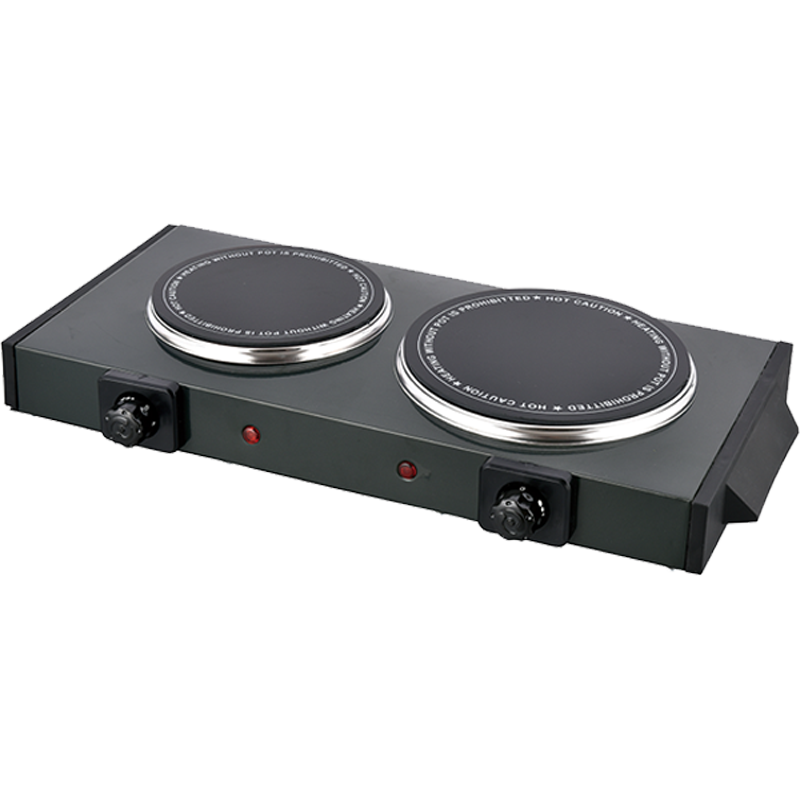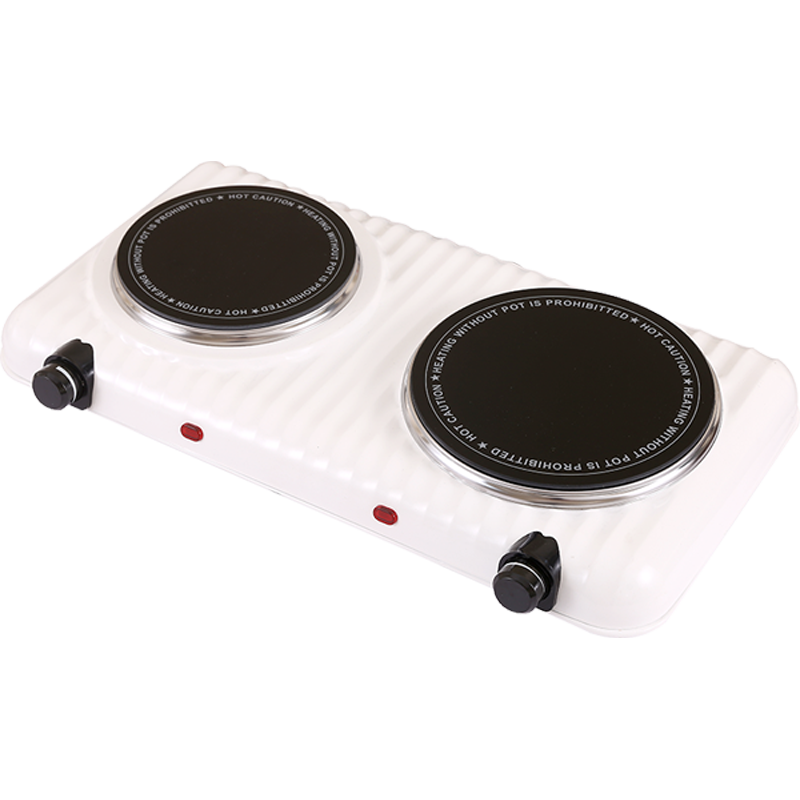+86-579-87253168
What is a Hookah Burner?
A hookah burner is an essential device used to heat the charcoal that powers a hookah. The primary function of a hookah burner is to provide a consistent heat source for the charcoal, which in turn generates the necessary temperature to vaporize the hookah tobacco or shisha, allowing users to enjoy the flavors of their smoking experience. The heat produced by the burner also helps to ignite the charcoal, enabling it to glow red and produce the smoke needed for inhalation.
While the term "hookah burner" may seem simple, there are many features that can differentiate one burner from another. Understanding the role of a hookah burner in the overall hookah experience is important, as it not only affects the quality of the smoke but also the safety, convenience, and duration of your hookah session.
The Importance of Hookah Burners in the Hookah Experience
A hookah burner may seem like a simple accessory in the overall hookah setup, but it plays a critical role in ensuring that your smoking experience is smooth, flavorful, and safe. The primary function of a hookah burner is to generate the necessary heat to burn the charcoal, which, in turn, heats the shisha tobacco and produces the vapor that is inhaled. Without the right burner, the hookah session can be compromised, leading to a less enjoyable experience, inconsistent flavor, and even safety hazards.
1. Maintaining Consistent Heat for Optimal Smoke
One of the most essential roles of a hookah burner is maintaining a stable and consistent temperature for the charcoal. The temperature directly impacts the performance of the hookah, including the quality of the smoke and the flavor of the tobacco. If the temperature fluctuates too much, it can lead to uneven burning, resulting in a harsh or weak smoke.
A good hookah burner helps keep the charcoal glowing at an ideal temperature, ensuring that the tobacco is vaporized evenly. This consistency is key to producing thick, smooth, and flavorful clouds of smoke. Without it, the session may become unpleasant, with uneven burning and an unbalanced taste.
2. Enhancing Flavor and Smoothness
The taste of the smoke depends on several factors, including the temperature at which the tobacco is burned. If the charcoal is not heated evenly, some areas of the tobacco may burn too quickly, leading to a burnt, bitter taste. On the other hand, if the charcoal doesn't reach the right temperature, the tobacco may not burn efficiently, resulting in a weak or muted flavor.
A high-quality hookah burner helps to mitigate these issues by evenly distributing the heat. By ensuring that the charcoal stays at a stable temperature, the burner allows the tobacco to vaporize at the ideal rate, delivering the smooth, rich flavors that are characteristic of a great hookah session.
3. Improving Smoke Quality
The density and smoothness of the smoke are greatly influenced by the heat provided by the hookah burner. Consistent heat ensures that the tobacco burns properly, creating thick, voluminous clouds of smoke that are both satisfying and enjoyable. If the heat is uneven, the smoke may be thin and harsh, leading to a less enjoyable experience.
Furthermore, the control of heat helps prevent the tobacco from burning too quickly, which can lead to an undesirable burnt taste. By regulating the heat, the burner helps produce smoke that is full-bodied and flavorful, creating a more satisfying experience for the smoker.
4. Ensuring Safety During the Session
Safety is another crucial aspect of the hookah experience, and the burner plays an essential role in ensuring safe use. Traditional charcoal burners can be particularly dangerous if they are not used properly. If the charcoal gets too hot or is placed in an unstable position, it could cause fire hazards, especially when used near flammable materials.
Electric hookah burners, on the other hand, often come with safety features such as auto-shutoff functions or temperature control to prevent overheating. Regardless of the type of burner, safety remains a priority. A properly designed burner will reduce the risk of accidents, ensuring that the smoker can focus on enjoying the experience rather than worrying about safety concerns.
5. Convenience and Ease of Use
Another factor that makes hookah burners important is the convenience they provide. The ease with which you can heat and maintain the charcoal impacts the overall enjoyment of the session. Traditional charcoal burners require close attention to ensure the charcoal is burning properly, while electric burners provide a more hands-off approach by automatically regulating the heat.
The convenience of having a reliable hookah burner can make the difference between a smooth, relaxed session and one that is plagued with constant adjustments. A good burner will allow you to enjoy your hookah without the constant need to monitor the temperature or replace the charcoal.
6. Influence on Session Duration
The longevity of your hookah session can also be affected by the burner. If the burner doesn’t maintain the right temperature, the charcoal may burn too quickly, cutting the session short. On the other hand, a good hookah burner helps extend the duration of the session by ensuring that the charcoal lasts longer, allowing you to enjoy the hookah at a comfortable pace.
Some electric burners are designed to heat the charcoal more efficiently, allowing for longer sessions without needing to replace the charcoal frequently. This can be especially important for group sessions or extended smoke breaks.
7. Aesthetic Appeal and Customization
In addition to functionality, hookah burners can also add to the overall aesthetic of the hookah setup. Many modern burners are designed to be visually appealing, featuring sleek and stylish designs that complement the hookah. Some even allow for customization, so users can personalize their setup to match their style or preferences.
While aesthetics may not directly impact the quality of the smoke, they can certainly enhance the overall experience, making the process more enjoyable and engaging.
Benefits of Using a Quality Hookah Burner
When it comes to enjoying a perfect hookah session, the burner plays a fundamental role in enhancing the overall experience. A quality hookah burner can make a significant difference in the smoothness of the smoke, the consistency of the heat, and the overall safety of the session. Whether you're an experienced smoker or a newcomer, using a high-quality burner can elevate your hookah sessions to a whole new level.
1. Consistent Heat for Optimal Performance
One of the primary advantages of a high-quality hookah burner is its ability to provide consistent heat. Maintaining a steady, reliable temperature is crucial for ensuring that the hookah tobacco burns evenly, which directly affects the quality of the smoke. Inconsistent heat can lead to uneven burning of the charcoal, which can result in harsh, bitter smoke or weak flavor.
With a quality burner, the temperature remains steady throughout the session, ensuring that the charcoal continues to glow at the ideal temperature. This consistency allows the tobacco to vaporize evenly, resulting in smooth, rich, and flavorful smoke. Whether you're smoking for an hour or just a few minutes, the right burner will provide the heat necessary for an optimal experience from start to finish.
2. Enhanced Flavor and Smoothness
The flavor of the smoke is a crucial aspect of any hookah session. A high-quality burner helps maintain the right temperature, which allows the tobacco to burn evenly and release its full flavor profile. If the heat fluctuates too much, it can lead to a burnt taste or weak flavor, which can spoil the session.
A well-regulated burner ensures that the tobacco is vaporized at the correct temperature, unlocking its full flavor potential. The smoke becomes smooth, enjoyable, and free from harshness. As a result, users can enjoy a much richer and more satisfying flavor with each puff, enhancing the overall enjoyment of the hookah experience.
3. Improved Smoke Density
Another significant benefit of using a quality hookah burner is the improved density of the smoke. Consistent heat is essential for producing thick, voluminous clouds of smoke. When the charcoal burns evenly, the smoke produced is denser and more substantial, creating a more satisfying and immersive experience.
A high-quality burner ensures that the heat is evenly distributed, which results in the production of fuller, thicker clouds of smoke. This is especially important for those who enjoy the visual appeal of hookah smoke or who prefer a more substantial smoking experience. With a good burner, you'll notice a dramatic difference in the smoke density, making your hookah sessions more enjoyable.
4. Faster Heating Time
A top-tier hookah burner can also provide faster heating times, reducing the wait before you can start enjoying your session. Traditional charcoal burners often take a while to heat the charcoal to the right temperature, which can be frustrating for users who want a quick and easy setup.
Electric hookah burners, in particular, are designed to heat the charcoal more efficiently. With advanced heating elements and temperature control mechanisms, these burners can reach the ideal temperature much faster than traditional methods. As a result, you'll spend less time waiting and more time enjoying your hookah.
5. Safety and Reduced Risk of Accidents
Safety is always a priority when dealing with heat and fire, especially with the open flames involved in traditional hookah setups. Quality hookah burners, particularly electric ones, come with built-in safety features to minimize the risk of accidents. Many electric models are designed with automatic shut-off functions, temperature regulation, and heat protection, ensuring that the device doesn't overheat or malfunction.
Traditional charcoal burners, when used properly, can also offer safety benefits. High-quality models are built to withstand high temperatures and are designed to be stable, reducing the risk of tipping over or causing a fire hazard. By using a quality burner, you ensure that your hookah session remains safe and hassle-free.
6. Durability and Longevity
Investing in a quality hookah burner often means that you'll have a product that is built to last. High-quality burners are typically made from durable materials, designed to withstand the intense heat generated during use. Whether you choose a charcoal burner or an electric model, a quality burner will resist wear and tear over time, making it a long-term investment.
Cheaper, low-quality burners may break down or wear out quickly, leading to frequent replacements. A well-built hookah burner, however, can provide years of reliable service, saving you money in the long run. Durability is particularly important if you use your hookah burner regularly or in outdoor settings, where it may be subjected to harsh conditions.
7. Convenience and Ease of Use
A quality hookah burner is designed for convenience, making it easy to use and maintain. Electric hookah burners, for example, often come with user-friendly features such as adjustable heat settings, timers, and automatic shut-off functions. These features make it simple to control the heat and avoid overheating the charcoal, which can lead to unwanted flavor changes.
Traditional charcoal burners can also offer convenience in their design. High-quality burners often feature well-thought-out trays or bases that securely hold the charcoal and allow for even heating. Many models are portable and lightweight, making them ideal for use in various settings, from the home to outdoor gatherings.
8. Cost-Effectiveness in the Long Run
While a quality hookah burner may come with a higher upfront cost, it often proves to be more cost-effective in the long run. A high-quality burner is built to last, reducing the need for frequent replacements or repairs. Additionally, the consistent heat it provides can help you maximize the use of your charcoal, ensuring that you get more out of each session.
Investing in a well-made burner can save you money by preventing unnecessary wastage and improving the efficiency of your hookah sessions. With better heat regulation and longer-lasting performance, a quality burner ensures that you get value for your money over time.
Types of Hookah Burners and Their Applications
A hookah burner is essential for creating the right conditions to enjoy your hookah experience. While the primary function of any hookah burner is to generate heat for burning the charcoal, the type of burner you use can significantly affect the overall performance, ease of use, and safety of your smoking session. Understanding the different types of hookah burners and their respective applications will help you select the best option to suit your needs.
1. Charcoal Hookah Burners
Traditional charcoal burners are the most common type of burner used in hookah smoking. These burners are designed to heat natural charcoal, which is the most widely used fuel source in hookahs. Charcoal burners use either an open flame or a heating coil to ignite and maintain the temperature of the charcoal.
Applications:
Outdoor and Group Sessions: Charcoal burners are typically used in outdoor settings or larger group sessions where portability and a more traditional smoking experience are desired. Their simple design makes them easy to use for those who enjoy the ritual of lighting the charcoal manually.
Cost-Effective Option: Charcoal burners are often the most affordable option and are widely used by people who enjoy the process of heating the charcoal themselves.
Advantages:
Traditional Hookah Experience: Many hookah enthusiasts prefer charcoal burners because they provide an authentic, hands-on experience.
Widely Available: Charcoal burners are available in a variety of shapes and sizes to suit different preferences and budgets.
Limitations:
Longer Heating Time: Charcoal burners typically require more time to heat the charcoal to the ideal temperature, and the user must often monitor and adjust the charcoal to maintain consistent heat.
2. Electric Hookah Burners
Electric hookah burners are a modern alternative to traditional charcoal burners. These devices use electricity to generate heat, which is then transferred to the charcoal to keep it glowing. Electric burners are usually equipped with heating elements or coils that are capable of reaching and maintaining the necessary temperature quickly and efficiently.
Applications:
Indoors and Convenient Use: Electric hookah burners are ideal for indoor use due to their clean and controlled heating system. They are perfect for people who want a hassle-free setup and don't want to deal with the mess of charcoal or the need for constant monitoring.
Smaller or Single-User Sessions: These burners are also excellent for individual use or small group sessions, providing a quick and efficient way to enjoy hookah without worrying about constant heat adjustments.
Advantages:
Quick Heating: Electric burners heat the charcoal much faster than traditional methods, allowing users to begin their session sooner.
Ease of Use: With no need for an open flame or manual heat management, electric burners are easy to operate and require minimal effort.
Safety Features: Many electric models come with built-in safety features such as temperature regulation and automatic shut-off, reducing the risk of overheating and accidents.
Limitations:
Dependence on Electricity: Electric burners require a power source, which limits their use to indoor settings or locations with electricity available.
Higher Initial Cost: Electric hookah burners are generally more expensive than traditional charcoal burners, though they can save time and effort in the long run.
3. Hybrid Hookah Burners
Hybrid hookah burners are a combination of traditional charcoal burners and modern electric models. These versatile burners can be used with either natural charcoal or electric heating elements, providing users with the flexibility to choose their preferred heat source. Hybrid burners often have a compartment that can hold both types of fuel, allowing for easy switching between them based on the user’s needs.
Applications:
Versatility for Different Settings: Hybrid burners are suitable for both indoor and outdoor use, as they offer the option to use either electric heating or charcoal. This flexibility makes them a great choice for people who want to adapt their hookah sessions to various environments and conditions.
Convenient for Travelers: These burners are often compact and portable, making them an excellent choice for individuals who enjoy smoking on the go, whether camping or traveling.
Advantages:
Flexibility: The ability to switch between charcoal and electric heating allows users to choose the best option based on the location and their preference.
Adaptable to Various Environments: Whether you're at home or outdoors, hybrid burners offer the convenience of both heating methods.
Limitations:
More Complex to Use: The combination of two heating methods can make hybrid burners slightly more complicated to operate, especially for beginners.
Potentially Larger and Heavier: Some hybrid models can be bulkier than standard electric or charcoal burners, which may reduce portability.
4. Portable Hookah Burners
Portable hookah burners are smaller, lightweight versions of traditional or electric burners that are designed for on-the-go use. These compact burners are perfect for those who want to take their hookah setup outdoors, whether at a park, beach, or during a camping trip. They typically run on battery power or are small enough to operate with a portable fuel source.
Applications:
Outdoor and Travel-Friendly Use: Portable burners are ideal for outdoor enthusiasts and travelers who want to enjoy a hookah session away from home. Their small size and easy setup make them convenient for impromptu sessions or trips where space is limited.
Solo and Small Group Sessions: These burners are often used by individuals or small groups looking for a more flexible, portable option.
Advantages:
Portability: The main benefit of portable hookah burners is their ease of transport. They can be carried easily in a bag or case, making them perfect for on-the-go smoking.
Simplicity: These burners are designed to be user-friendly, providing a quick and easy setup without the need for complicated preparation.
Limitations:
Limited Power and Capacity: Portable burners may not have the same power or capacity as larger, stationary models, which can limit their effectiveness for larger groups or extended sessions.
Smaller Heating Surface: Due to their size, portable burners may not provide the same level of heat distribution as larger, traditional burners.
5. Gas Hookah Burners
Gas-powered hookah burners use propane or butane to generate the heat required to ignite and maintain the charcoal. These burners are commonly used in outdoor or mobile environments, where a portable heat source is necessary. Gas burners are designed to offer more power than traditional charcoal burners and can heat charcoal more efficiently.
Applications:
Outdoor and Camping: Gas-powered burners are ideal for outdoor enthusiasts, campers, and those who frequently travel. Their portability and efficiency make them a popular choice for smoking outdoors.
Heavy-Duty Sessions: For users who require more heat or longer hookah sessions, gas burners offer a more powerful option compared to electric models.
Advantages:
Efficient Heating: Gas burners can provide a faster and more powerful heat source, allowing users to quickly prepare their hookah.
Outdoor Use: Since they don't require electricity, gas burners are perfect for locations without access to power, such as in nature or while traveling.
Limitations:
Dependence on Gas Canisters: Gas burners require a supply of gas canisters, which need to be replaced regularly, adding to the ongoing cost.
Higher Safety Risks: Gas-powered burners involve open flames and flammable gases, requiring extra caution and proper ventilation during use.
| Type of Hookah Burner | Description | Applications | Advantages | Limitations |
|---|---|---|---|---|
| Charcoal Hookah Burners | Traditional burners that use open flame or heating coils to ignite natural charcoal. | Outdoor and group sessions, cost-effective options. | Traditional hookah experience, widely available. | Longer heating time, manual heat management required. |
| Electric Hookah Burners | Burns charcoal using electricity through heating elements or coils. | Indoor use, small group or individual sessions. | Quick heating, ease of use, safety features (auto-shutoff). | Dependence on electricity, higher initial cost. |
| Hybrid Hookah Burners | Combines both charcoal and electric heating methods for flexibility. | Versatile, indoor/outdoor use, travel-friendly. | Flexibility to switch between heating methods, adaptable. | More complex to use, bulkier and heavier than other types. |
| Portable Hookah Burners | Small, lightweight burners designed for travel and outdoor use. | Ideal for travel, outdoor sessions, and solo or small group use. | Highly portable, easy to use, convenient for on-the-go smoking. | Limited power/capacity, smaller heating surface. |
| Gas Hookah Burners | Uses propane or butane to generate heat for charcoal burning. | Outdoor, camping, heavy-duty sessions. | Powerful heating, perfect for extended or outdoor sessions. | Dependence on gas canisters, higher safety risks due to open flames. |
What Are the Differences Between Charcoal and Electric Hookah Burners?
When it comes to heating charcoal for hookah, charcoal and electric hookah burners are the two most common options. While both serve the same fundamental purpose—heating charcoal to a temperature that enables it to burn and vaporize hookah tobacco—there are significant differences between the two in terms of functionality, convenience, and overall performance.
1. Heating Method: Traditional vs. Modern
Charcoal Hookah Burners: Charcoal burners rely on open flame or heating coils to ignite and heat natural charcoal. These burners often have a tray or platform where the charcoal is placed, and the heat source either radiates or is applied directly to the charcoal to get it glowing. The user typically needs to manually control the temperature by adding or adjusting the charcoal.
Electric Hookah Burners: Electric hookah burners, on the other hand, use an electric heating element, such as a coil or plate, to heat the charcoal. The process is more controlled and automatic, with many electric models featuring adjustable heat settings that allow the user to fine-tune the temperature for optimal smoking conditions.
Key Difference: The primary distinction lies in the heating method—charcoal burners require an open flame or direct heating, while electric burners use electrical elements for more consistent and adjustable heat.
2. Heat Control and Consistency
Charcoal Hookah Burners: The heat in charcoal burners tends to be less consistent, as the charcoal burns unevenly, especially if the airflow isn’t properly managed. This can result in hot spots or areas where the charcoal burns too quickly, leading to fluctuations in temperature and smoke quality. To maintain an even heat, the user often has to monitor the charcoal and adjust it manually, which can be time-consuming.
Electric Hookah Burners: One of the key advantages of electric hookah burners is their ability to provide consistent heat throughout the session. The electric element evenly distributes heat, allowing for a stable and uniform burn. Many electric models also offer precise temperature control, ensuring that the charcoal remains at the optimal temperature for the best smoking experience.
Key Difference: Electric burners excel in providing consistent heat, while charcoal burners can experience fluctuations in temperature that may affect smoke quality.
3. Convenience and Ease of Use
Charcoal Hookah Burners: Using a charcoal burner requires more hands-on effort. The user needs to light the charcoal, manage the heat manually, and ensure that the charcoal stays in place. Additionally, if you're using a traditional burner, it may take some time for the charcoal to reach the ideal temperature. Once the charcoal starts to burn down, it also needs to be replaced.
Electric Hookah Burners: Electric burners are far more convenient to use. They are typically designed to heat the charcoal automatically, so there’s no need for constant monitoring or adjustments. Most electric burners also have a faster heating time compared to traditional charcoal burners, allowing users to start their hookah session almost immediately after setup.
Key Difference: Electric burners provide a much more hands-off experience, while charcoal burners require more time, effort, and attention to maintain the heat.
4. Safety Considerations
Charcoal Hookah Burners: Safety is a significant concern with charcoal burners, as they involve open flames or high temperatures that can be dangerous if not carefully managed. Charcoal itself can cause fires if handled improperly, and there’s also a risk of carbon monoxide buildup in poorly ventilated spaces.
Electric Hookah Burners: Electric burners are generally safer because they don’t involve open flames. Many electric models are equipped with built-in safety features like automatic shut-off functions and temperature regulation to prevent overheating. This reduces the risk of accidents, making electric burners a safer option, especially for indoor use.
Key Difference: Electric burners are safer, especially for indoor use, because they eliminate the need for open flames, while charcoal burners come with inherent fire and ventilation risks.
5. Portability and Flexibility
Charcoal Hookah Burners: Charcoal burners are often portable and can be used in a variety of settings, such as outdoor hookah sessions, camping trips, or at social gatherings. They don't require an electrical outlet, making them versatile for on-the-go use. However, they might require additional tools like lighters or matches for ignition.
Electric Hookah Burners: While electric burners offer ease of use, they require access to a power source, which limits their portability. They are best suited for indoor use or places where electricity is readily available. Some models, however, are compact enough for limited outdoor use if a power source is accessible.
Key Difference: Charcoal burners are more portable and can be used outdoors without relying on electricity, while electric burners are better suited for indoor use where power is available.
6. Cleaning and Maintenance
Charcoal Hookah Burners: Charcoal burners generally require more maintenance due to the soot, ash, and residue left behind by the burning charcoal. After each use, the burner needs to be cleaned thoroughly to ensure it remains in good working condition. Additionally, the charcoal tray or platform can accumulate buildup that needs to be wiped or washed off.
Electric Hookah Burners: Electric burners are easier to clean compared to charcoal burners, as they don’t produce ash or soot. The main maintenance involves keeping the heating element free of debris or buildup, which is usually simpler and less time-consuming. However, electric burners still require regular care to ensure the heating element remains functional.
Key Difference: Electric burners are easier to clean and maintain, while charcoal burners require more effort to keep clean due to the ash and residue.
7. Cost
Charcoal Hookah Burners: Charcoal burners are generally more affordable upfront, making them a budget-friendly option for hookah enthusiasts. However, since they require charcoal regularly, the ongoing cost can add up over time.
Electric Hookah Burners: Electric burners usually come with a higher initial cost compared to charcoal models, due to their advanced features and heating technology. However, since they don't require charcoal and have lower long-term maintenance costs, the overall expenditure can be more economical in the long run.
Key Difference: Charcoal burners have a lower initial cost but higher ongoing expenses, while electric burners are more expensive upfront but could be more cost-efficient over time.
| Aspect | Charcoal Hookah Burners | Electric Hookah Burners |
|---|---|---|
| Heating Method | Relies on open flame or heating coils to ignite and heat charcoal. | Uses electric heating elements to generate heat for the charcoal. |
| Heat Control & Consistency | Heat tends to fluctuate, requiring manual adjustments. | Provides consistent, even heat with precise temperature control. |
| Convenience | Requires manual lighting, monitoring, and adjustment of charcoal. | Quick and automatic heating, minimal monitoring or effort needed. |
| Safety | Involves open flames, which pose fire risks and require ventilation. | Safer with no open flames, often includes safety features like auto-shutoff. |
| Portability | Highly portable and can be used outdoors without electricity. | Less portable due to dependence on electricity; best for indoor use. |
| Cleaning & Maintenance | Requires more maintenance due to ash, soot, and residue buildup. | Easier to clean with fewer residues; mainly requires care for the heating element. |
| Cost | Low initial cost but higher ongoing cost for charcoal. | Higher upfront cost but potentially lower long-term costs. |
| Use Environment | Ideal for outdoor or group settings, requiring more manual effort. | Best for indoor use, offering a convenient and hands-off experience. |
How a Hookah Burner Works
A hookah burner is a vital part of the hookah smoking process, as it provides the necessary heat to ignite and maintain the charcoal. Whether you're using a traditional charcoal burner or a modern electric burner, understanding how these devices work can enhance your hookah experience.
1. The Basics of a Hookah Burner
The primary purpose of a hookah burner is to generate enough heat to activate the charcoal used in the hookah. This heat is essential for the burning of the tobacco, which in turn produces the smoke. A good burner ensures that the charcoal remains at a consistent temperature throughout the smoking session, providing the ideal conditions for smooth, flavorful smoke.
While the basic function of all hookah burners is the same—to generate heat for charcoal—there are different methods of heating depending on the type of burner. Let's look at the process in more detail.
2. How Charcoal Hookah Burners Work
Charcoal hookah burners are the traditional choice for heating the charcoal. They typically consist of a metal tray or surface where charcoal is placed, with a heat source either below or surrounding it. The heat source can be an open flame, heating coil, or electric heating element.
Here's how the heating process works in a traditional charcoal burner:
Ignition: The user either lights the charcoal directly using a flame or places the charcoal in an electric coil or burner that gradually heats up.
Heat Distribution: Once lit, the charcoal starts to glow, and the heat spreads throughout the piece, reaching the ideal temperature for burning. The heat from the glowing charcoal is transferred to the tobacco through the heat resistance of the hookah bowl.
Ongoing Heat Regulation: The user may need to adjust the charcoal periodically to ensure an even burn. If the charcoal burns down too quickly or unevenly, more charcoal may need to be added or repositioned for better heat control.
3. How Electric Hookah Burners Work
Electric hookah burners are an advanced alternative to traditional charcoal burners, offering more convenience and control. These devices use electrical elements like heating coils or plates to produce heat, which is transferred to the charcoal. The process is automated, making it a more hands-off experience.
Here's a breakdown of how electric hookah burners work:
Power Source: Electric burners are plugged into an electrical outlet or powered by batteries (in some portable models). The heating element is activated as soon as the device is powered on.
Heating the Charcoal: The electric burner gradually heats the coil or plate, which in turn heats the charcoal placed on it. These burners are often designed with temperature control systems to regulate the heat evenly.
Maintaining Heat: Once the charcoal reaches the desired temperature, the electric burner maintains it at a constant level. Some advanced models have temperature sensors to ensure the charcoal stays at an optimal burning temperature throughout the session.
4. Heat Transfer Mechanisms
In both charcoal and electric burners, heat transfer is the key process that enables the charcoal to maintain the correct temperature for an extended period. Here’s how heat is transferred in both cases:
Conduction: In both types of burners, heat moves through direct contact. For instance, with electric burners, heat is conducted directly from the heating element to the charcoal. In traditional charcoal burners, heat is transferred from the flame or coils to the charcoal.
Radiation: Charcoal itself generates radiant heat as it glows. This radiant heat is transferred to the tobacco in the hookah bowl, causing the tobacco to burn and vaporize.
5. Control and Regulation of Heat
The way heat is controlled and regulated depends on the type of burner. In charcoal burners, the heat is more manually controlled by adjusting the charcoal placement, adding or removing pieces as needed. In electric burners, temperature control is more automated and precise. Many electric models come with built-in thermostats or heat sensors, allowing users to set and maintain the ideal temperature for consistent smoking.
6. Burner Material and Design
The material of the burner plays an important role in how efficiently it can transfer heat and maintain a consistent temperature. Most charcoal burners are made of metal, which can withstand high heat and provide good heat distribution. Some electric burners may use ceramic or other heat-resistant materials to enhance the burner's longevity and efficiency.
7. Safety Features in Electric Hookah Burners
Electric hookah burners often come equipped with a variety of safety features that reduce the risk of accidents. These can include:
Overheat Protection: Many electric burners automatically shut off if the temperature exceeds a certain threshold to prevent overheating.
Temperature Control: Some models include temperature regulation features to ensure the charcoal never gets too hot, protecting both the user and the device.
Automatic Shut-off: A feature in many electric models that cuts off power when the burner is left on for too long, reducing fire hazards.
8. The User Experience
Both charcoal and electric burners provide unique user experiences:
Charcoal Burners: They offer a traditional, hands-on experience, allowing users to enjoy the ritual of preparing the charcoal and controlling the heat. However, they require more attention and monitoring to maintain a consistent heat throughout the session.
Electric Burners: These are more convenient, offering a nearly effortless hookah experience. With automatic heating and precise control, electric burners take the guesswork out of the process, allowing users to enjoy consistent and high-quality smoke with less effort.
How to Choose the Right Hookah Burner for Your Needs
Selecting the right hookah burner can significantly enhance your hookah experience, making it more enjoyable and efficient. Whether you're a seasoned hookah enthusiast or a beginner, choosing the right burner involves considering several factors, such as heating method, convenience, portability, and safety.
1. Consider the Type of Heat Source
The first decision to make when choosing a hookah burner is deciding between traditional charcoal or modern electric heating methods.
Charcoal Burners: If you prefer a traditional hookah experience, a charcoal burner might be the right choice. These burners rely on either an open flame or heating coils to ignite and maintain the heat of natural charcoal. While they provide a more authentic smoking experience, they require more manual control to manage the temperature and charcoal placement.
Electric Burners: If convenience and consistency are important to you, an electric burner may be the better option. These burners use electricity to heat a coil or plate, which then heats the charcoal. They often feature temperature control and automatic shut-off features, providing a more hands-off approach with consistent heat throughout the session.
Tip: If you're new to hookah smoking, you might prefer the ease and consistency of an electric burner, while seasoned smokers might enjoy the hands-on process of using a charcoal burner.
2. Evaluate Your Preferred Smoking Environment
The environment where you plan to use your hookah burner plays a crucial role in determining which model will best meet your needs.
Indoor Use: If you'll primarily use your hookah indoors, an electric burner is often the best choice. It eliminates the need for open flames, reducing safety concerns and smoke inhalation. Additionally, electric burners provide more consistent heat, making them ideal for creating a smooth smoking experience indoors.
Outdoor Use: If you plan to take your hookah outdoors, such as camping or having a hookah session in your backyard, a charcoal burner is generally more suitable. Charcoal burners are more portable and don't rely on electricity, making them easy to transport and set up in outdoor settings. However, ensure that you have enough space and a safe environment to handle the open flame.
Tip: For indoor use, prioritize electric burners for ease of use and safety. For outdoor settings, choose charcoal burners for portability and flexibility.
3. Assess Heat Control Features
One of the most important aspects of any hookah burner is its ability to maintain consistent heat. Inconsistent heat can lead to uneven smoking and a poor experience.
Charcoal Burners: These require manual control over the heat. You’ll need to adjust the charcoal periodically to ensure it burns evenly. While this provides a more authentic experience, it requires attention and effort from the user.
Electric Burners: Many electric burners come with temperature control features that allow you to set the heat to your desired level. Some models include sensors that maintain a consistent temperature, reducing the need for manual adjustments and ensuring a stable heat source throughout the session.
Tip: If you're looking for consistency with minimal effort, an electric burner with temperature control is the ideal choice. If you enjoy the ritual and don’t mind manual adjustments, a charcoal burner could be perfect for you.
4. Consider Portability and Size
Portability is another important consideration, especially if you plan to take your hookah on the go or need a burner that won’t take up much space.
Charcoal Burners: These tend to be more portable, as they don't require electricity. Many models are compact and can easily be transported to different locations. However, they may require additional tools, such as lighters or matches, to ignite the charcoal.
Electric Burners: While electric burners may be larger due to their heating elements and power sources, many modern electric models are designed to be compact and portable enough for home use. However, remember that they will require a nearby power outlet to function, limiting their portability outdoors.
Tip: For portability, charcoal burners are generally better suited for outdoor use. For home use, if portability is less of a concern, an electric model will provide more convenience and consistency.
5. Safety Considerations
Safety is crucial when selecting a hookah burner, especially if you're using it indoors or in confined spaces. Charcoal burners inherently carry more risk due to the open flame and the heat involved.
Charcoal Burners: These can be more dangerous as they involve fire, which can lead to accidental burns or fires if not handled correctly. If you're using a charcoal burner, make sure to have proper ventilation, and avoid using it near flammable materials.
Electric Burners: Electric hookah burners are generally safer to use indoors, as they eliminate the open flame. Many electric models also feature built-in safety features such as automatic shut-off mechanisms or overheat protection, which reduce the risk of accidents.
Tip: If safety is a top concern, especially for indoor use, opt for an electric burner with built-in safety features. For outdoor use, a charcoal burner can be handled more safely if proper precautions are taken.
6. Maintenance and Cleaning
Maintenance is an often-overlooked aspect of hookah burners, but it's essential for ensuring long-term performance.
Charcoal Burners: These typically require more cleaning because of the ash and soot that accumulate after use. You’ll need to regularly clean the tray and any surfaces that come into contact with the charcoal to prevent buildup.
Electric Burners: Electric burners are generally easier to clean as they don’t produce ash or soot. However, they may require cleaning of the heating element and ensuring no debris interferes with the heat source.
Tip: If you prefer low-maintenance options, an electric burner will require less frequent cleaning. Charcoal burners, while offering an authentic experience, demand more attention when it comes to upkeep.
7. Price Considerations
Price is another important factor when selecting a hookah burner. While charcoal burners are typically less expensive upfront, they do incur ongoing costs for charcoal. On the other hand, electric burners come with a higher initial cost but have the advantage of using electricity, which is typically cheaper than purchasing charcoal.
Tip: If you're on a tight budget and don't mind managing heat manually, a charcoal burner may be more affordable in the long run. However, if you want a more convenient and consistent experience, an electric burner might be worth the investment despite the higher upfront cost.
How Do You Maintain and Clean Your Hookah Burner?
Proper maintenance and cleaning of your hookah burner are essential for ensuring optimal performance, longevity, and safety. Whether you use a charcoal or electric hookah burner, regular cleaning not only helps maintain smooth and consistent heat but also prevents buildup of ash, soot, and residue that can affect the quality of your smoking experience.
1. Why Is Cleaning Important?
Over time, the heating process can cause soot, ash, and tobacco residue to accumulate on the burner. These materials can affect the efficiency of the burner and potentially cause the device to overheat or malfunction. A clean burner ensures that heat is distributed evenly, helps avoid unpleasant odors, and extends the life of the burner.
Here are some reasons why cleaning is essential:
Prevents Ash Buildup: Ash from the charcoal can accumulate on the burner and reduce heat transfer.
Improves Performance: A clean burner ensures consistent heat, which is vital for a smooth smoking session.
Prevents Odors: Residue and buildup can create unpleasant smells when the burner is heated. Regular cleaning helps prevent this.
Safety: Over time, dirt and residue buildup can interfere with the burner's safety mechanisms, leading to overheating or potential fire hazards.
2. Cleaning a Charcoal Hookah Burner
Cleaning a charcoal hookah burner is a more hands-on process due to the ash and soot left behind after each use. Here's how to do it effectively:
Step 1: Let the Burner Cool
Before cleaning, always allow the burner to cool down completely. Charcoal burners can retain heat for a while, and cleaning them while they are hot can lead to burns or damage.
Step 2: Remove Ash and Charcoal Residue
Gently remove the ashes and any charcoal residue from the burner’s tray or surface. You can use a soft brush or cloth to wipe away any leftover charcoal particles. Avoid using harsh materials that can scratch or damage the burner.
Step 3: Clean the Heating Surface
If your charcoal burner has a coil or heating element, make sure to wipe it down gently with a damp cloth to remove any soot or buildup. Be cautious not to wet the electrical components if the burner uses electricity.
Step 4: Wash the Burner (If Applicable)
If the burner has a removable tray or parts that can be washed, wash them in warm soapy water. Make sure they are thoroughly dry before reassembling the burner. Avoid immersing the entire burner in water, especially if it has electrical components.
Step 5: Regularly Check for Wear and Tear
Over time, the charcoal burner may show signs of wear and tear. Inspect the components, such as the tray or heating coils, to ensure they remain intact and functional. Replace damaged or worn parts promptly to ensure the safety and efficiency of the burner.
3. Cleaning an Electric Hookah Burner
Electric hookah burners are typically easier to clean than their charcoal counterparts because they do not produce ash or soot. However, they still require regular maintenance to keep the heating element functioning correctly. Here's a guide for cleaning an electric hookah burner:
Step 1: Turn Off and Unplug the Burner
For safety reasons, always unplug the burner or turn it off before cleaning. If the burner has a battery or plug-in component, ensure that it is disconnected from the power source.
Step 2: Clean the Heating Element
Use a soft cloth or microfiber towel to wipe down the heating element. Be gentle to avoid damaging the coils or heating plate. Do not use excessive moisture, as this could damage the electrical parts. If there is any visible buildup, a damp cloth should suffice to clean it.
Step 3: Remove Surface Dust
Electric burners can accumulate dust or tobacco residue on the outer surfaces. Gently wipe the exterior with a soft cloth to keep it free from dust and dirt.
Step 4: Use Compressed Air for Hard-to-Reach Areas
If your electric hookah burner has vents or areas where dust or residue can accumulate, you can use a can of compressed air to blow away debris from hard-to-reach places. This will ensure your burner remains clean and efficient.
Step 5: Regularly Inspect for Safety Features
Electric hookah burners often have built-in safety features such as auto-shutoff or temperature regulation. Check that these features are working properly by conducting a quick test every now and then. If any safety mechanisms seem faulty, have the burner inspected or repaired by a professional.
4. General Maintenance Tips for Both Types of Burners
No matter the type of hookah burner you have, regular upkeep is essential for long-term performance. Here are some general maintenance tips for both charcoal and electric hookah burners:
Keep It Dry: Always make sure your hookah burner is completely dry before using it again. Any residual moisture can cause uneven heating or even damage electrical components.
Store Properly: When not in use, store your hookah burner in a dry, cool place to prevent dust, moisture, or accidental damage. For charcoal burners, store the charcoal in a separate, airtight container to prevent moisture from affecting it.
Avoid Overuse: Overuse can cause excessive buildup of residue and heat stress. Allow your burner to rest between sessions to avoid overworking it and causing premature wear.
Use the Right Charcoal: When using a charcoal hookah burner, always use high-quality charcoal to minimize the amount of ash and residue produced. The better the charcoal, the less you'll need to clean afterward.
5. Troubleshooting Common Issues
Even with regular cleaning and maintenance, you may encounter some common issues with your hookah burner. Here’s how to troubleshoot:
Uneven Heat: If your charcoal burner produces uneven heat, check for hot spots or inadequate airflow. In an electric burner, check if the heating element is malfunctioning or if there's a buildup obstructing the heat flow.
Slow Heating: If the burner is taking longer to heat up than usual, it may need a more thorough cleaning, or the heating element may need to be replaced.
Safety Features Not Working: For electric burners, if safety features like the auto-shutoff or temperature control aren’t working, it may indicate a malfunction in the device. In such cases, stop using the burner and contact a professional for repairs.
What Are the Safety Tips When Using a Hookah Burner?
Using a hookah burner, whether charcoal-based or electric, requires careful attention to safety. As a heat source, a hookah burner can pose fire risks if not handled properly. By following proper safety protocols, you can ensure a safe, enjoyable, and worry-free hookah experience.
1. Choose the Right Location
One of the first safety considerations when using a hookah burner is choosing the right location for setup. A safe environment minimizes the risks of fire hazards and ensures proper ventilation.
Indoors: Ensure the area is well-ventilated. Smoke can accumulate quickly, so having open windows or using a fan to circulate air is important. Avoid placing the burner near curtains, flammable materials, or anything that can catch fire.
Outdoors: When using a charcoal hookah burner outdoors, ensure the area is free from strong winds and dry grass or leaves. Wind can blow ashes, which may cause accidents, and dry conditions increase the risk of fire.
Tip: Set up your hookah burner on a stable, flat surface to prevent it from tipping over during use.
2. Monitor the Burning Charcoal
For charcoal hookah burners, the charcoal itself is a direct heat source and can remain hot long after use. Proper monitoring is essential for safe operation.
Avoid Overheating: Do not leave the burner unattended while the charcoal is heating. Overheating can result in dangerous situations, especially if the burner is left near flammable materials.
Proper Charcoal Handling: Always use tongs or heat-resistant gloves when handling burning charcoal. Never use bare hands to move or adjust the charcoal, as it can cause severe burns.
Tip: Always dispose of used charcoal properly by allowing it to cool down in a safe place. Never throw hot charcoal into the trash.
3. Use the Right Burner and Fuel
Using the correct hookah burner and fuel is crucial for both safety and performance.
Charcoal: Always use high-quality, suitable charcoal for your burner. Substandard charcoal can burn unevenly, producing excess heat or smoke that may be harmful to your health. Avoid using materials like lighter fluid to start the charcoal, as this can create dangerous fumes.
Electric Burners: If you are using an electric hookah burner, make sure it is connected to a power source that matches its specifications. Never use an electric burner with a damaged power cord, and always check for any signs of wear on the electric components before use.
Tip: Regularly inspect the fuel source to ensure it's appropriate for your burner and is stored properly.
4. Never Leave the Burner Unattended
A common cause of accidents related to hookah burners is leaving them unattended, particularly when using charcoal.
Charcoal Burners: If using a charcoal burner, never leave it unattended. Charcoal can burn for extended periods, posing a fire risk if left unchecked. Always wait until the charcoal has cooled before leaving the area.
Electric Burners: While electric burners are generally safer in terms of fire risk, it is still important to never leave them running when not in use. Always turn off the power and unplug the device when you're done.
Tip: Make it a habit to switch off the burner as soon as you're finished with your hookah session.
5. Ensure Proper Ventilation
Proper ventilation is essential, especially when using charcoal hookah burners, as they produce smoke and carbon monoxide, which can be harmful if inhaled in large quantities.
Indoors: Always use your hookah burner in a well-ventilated area to ensure smoke disperses safely. Avoid using the burner in enclosed spaces without proper air circulation, as smoke buildup can cause discomfort and pose health risks.
Outdoors: For outdoor use, ensure the area has enough airflow to dissipate smoke. Using the burner in a sheltered area, such as a gazebo or tent, may trap smoke and prevent proper ventilation.
Tip: Consider using a hookah fan or ventilation system to help disperse smoke in indoor spaces.
6. Use Fire-Resistant Tools
When handling a hookah burner, especially during charcoal setup and adjustments, always use fire-resistant tools.
Tongs and Gloves: For handling hot charcoal, use tongs or heat-resistant gloves to prevent burns. These tools allow you to adjust the charcoal or place it on the burner without direct contact with the heat.
Avoid Metal on Hot Coals: Do not use metal tools on a hot coal burner unless they are specifically designed to withstand high heat. Ordinary metal tools may heat up quickly, making them unsafe to touch.
Tip: Always store fire-resistant gloves and tongs near your burner to ensure they’re easily accessible when needed.
7. Inspect the Hookah Burner Regularly
Routine inspections of your hookah burner ensure that it remains in good working condition and prevents potential hazards.
Charcoal Burners: Check the burner for any signs of wear, such as rust, cracks, or damaged heating coils. These can cause malfunction and increase the risk of fire. Ensure that the tray or heating surface is intact and functional.
Electric Burners: Inspect the power cord, plug, and heating element regularly for signs of damage. If you notice any fraying wires, exposed parts, or malfunctioning components, stop using the burner and replace the damaged parts immediately.
Tip: Keep your burner clean and free of debris that may obstruct airflow or cause overheating.
8. Keep the Burner Away from Children and Pets
The heat and smoke generated by hookah burners can be dangerous to both children and pets. Keep your burner in a safe place away from these vulnerable groups.
Safe Storage: When not in use, store your hookah burner in a safe location where children or pets cannot access it. Ensure that hot parts of the burner are not within reach.
Supervision: Always supervise children and pets when the burner is in use. They should be kept at a safe distance to avoid burns or accidental contact with hot surfaces.
Tip: Consider using a barrier or safety screen around your burner if you have children or pets in the area.
9. Know How to Handle Emergencies
Despite following safety precautions, accidents may occur. Knowing how to handle emergencies can minimize damage or injury.
Fire: In case of fire, immediately use a fire extinguisher that is suitable for electrical or charcoal fires. Never use water on an electrical fire or burning charcoal.
Burns: If you suffer a burn from the burner, run cool water over the affected area for at least 10 minutes. For severe burns, seek medical attention immediately.
Tip: Keep a fire extinguisher and first aid kit nearby when using a hookah burner for peace of mind.
The Future of Hookah Burners
As the popularity of hookah continues to rise globally, the future of hookah burners is evolving with new innovations that promise to enhance the smoking experience while improving safety, convenience, and efficiency. With advancements in technology, changing consumer preferences, and a growing awareness of health and environmental concerns, hookah burners are expected to undergo significant transformations in the coming years.
1. The Rise of Electric Hookah Burners
Electric hookah burners are gaining significant traction in the market due to their convenience, safety features, and consistent heat output. Unlike traditional charcoal burners, which rely on manual lighting and constant supervision, electric models offer a more controlled and hands-off approach.
Smart Features: Future electric hookah burners are expected to include more advanced smart features, such as app-controlled settings, adjustable temperatures, and timers. This level of customization will allow users to tailor their smoking experience with precision, ensuring consistent heat for a smoother session.
Improved Efficiency: With the focus on energy efficiency, electric burners will become more powerful while consuming less energy. This will benefit users by lowering electricity costs and reducing the carbon footprint of hookah use.
Sustainability: As environmental concerns grow, electric burners are also more eco-friendly. They eliminate the need for charcoal, which contributes to carbon emissions and waste. By relying solely on electricity, these burners offer a more sustainable option for environmentally conscious consumers.
Tip: As electric models continue to evolve, they will likely become the go-to choice for consumers who value convenience and efficiency over the traditional charcoal experience.
2. Integration of Smart Technology
The integration of smart technology into hookah burners is poised to revolutionize the industry. Smart devices are already a part of many consumer products, and hookah burners are no exception.
Temperature Control and Monitoring: Future hookah burners could include advanced temperature sensors that automatically adjust the heat level to prevent overheating. These sensors would ensure a consistent smoking experience while eliminating the need for manual intervention, which is common with charcoal burners.
Connectivity: The ability to control your hookah burner via a mobile app or through voice commands using devices like Alexa or Google Assistant is a real possibility. This would allow users to set up their burner remotely and monitor the temperature and performance during use.
Safety Alerts: Enhanced safety features could include notifications when the burner is overheating, or if the charcoal or electric component is malfunctioning. These smart systems would add an extra layer of security, particularly for electric models, preventing accidents and extending the lifespan of the burner.
Tip: In the future, hookah enthusiasts could manage their entire hookah session from their smartphones, setting up their burners, adjusting heat levels, and ensuring safety—all from a distance.
3. Eco-Friendly Hookah Burners
Sustainability is a key concern for many modern consumers, and this trend is also making its way into the hookah industry. Traditional charcoal burners, which require the burning of natural charcoal, contribute to deforestation and pollution. As a result, there is growing demand for more eco-friendly alternatives.
Biodegradable Charcoal: In response to environmental concerns, manufacturers may introduce eco-friendly charcoal alternatives made from biodegradable materials or renewable resources. These types of charcoal would burn cleaner, produce less smoke, and have a significantly smaller environmental impact.
Waste Reduction: Future hookah burners, especially electric models, are likely to be designed with waste reduction in mind. These models may incorporate self-cleaning features that prevent residue buildup and extend the lifespan of the device.
Carbon Footprint Reduction: As the hookah industry moves toward a more sustainable future, more manufacturers will focus on reducing the carbon footprint of their products. Electric hookah burners, as discussed earlier, eliminate the need for charcoal, providing a greener option for consumers.
Tip: For environmentally conscious users, the future of hookah burners lies in the shift toward greener, more sustainable products, such as electric burners and biodegradable alternatives.
4. Improved Safety Features
Safety is always a priority when using a hookah burner, particularly with charcoal models. As the demand for safer products increases, the future of hookah burners will focus on better safety mechanisms to minimize the risks of burns, fire hazards, and overheating.
Auto-Shutoff Features: One of the most anticipated developments for both charcoal and electric hookah burners is the integration of auto-shutoff technology. This feature will automatically turn off the burner after a set period, preventing overheating and potential fire hazards.
Enhanced Heat Insulation: Future hookah burners will likely be designed with improved heat insulation to prevent burns from accidental contact with the outer surfaces. This is especially important for electric models that may reach high temperatures during use.
Fire-Resistant Materials: Manufacturers are likely to incorporate more fire-resistant materials in the construction of hookah burners, ensuring that the devices are safe to use around flammable materials. Additionally, safety certifications may become standard for all hookah burners to ensure reliability.
Tip: Look for hookah burners with built-in safety features such as auto-shutoff and heat insulation to enhance your overall safety during use.
5. Increased Customization and Personalization
The demand for personalized and customizable experiences is growing across various industries, and the hookah market is no different. In the future, consumers may be able to customize their hookah burners to fit their specific preferences and needs.
Customizable Heat Settings: Future hookah burners may offer even more precise control over the heat levels, allowing users to adjust the temperature for different types of tobacco or personal preferences. This level of customization would cater to a more diverse range of smoking experiences.
Interchangeable Parts: Some advanced models might allow users to swap out or customize parts of their hookah burner, such as the heating element, to achieve different effects or optimize the performance based on specific needs.
Aesthetic Personalization: With more emphasis on aesthetics, manufacturers may offer a wider range of designs and finishes, allowing users to choose a hookah burner that matches their style and preferences.
Tip: The future of hookah burners may involve a fully personalized smoking experience, where everything from heat levels to device appearance is tailored to the user's liking.
6. The Integration of Multi-Functional Features
As the demand for multifunctional products rises, hookah burners of the future could integrate multiple functions into a single device. These innovations may include:
Integrated Hookah Accessories: Future hookah burners may include features like built-in charcoal storage or easy-to-clean ash trays. This would streamline the process, making it more convenient for users to manage their hookah setup.
Dual-Functionality: Some hookah burners might serve dual purposes—acting as both a hookah burner and a heater for other activities, such as grilling or heating accessories.
Tip: Keep an eye on future hookah burner models that integrate multiple functionalities to provide more convenience and versatility for users.
The future of hookah burners is filled with exciting possibilities, from smarter, more efficient electric models to environmentally friendly alternatives and safer designs. As technology advances and consumer preferences shift, hookah burners will continue to evolve to meet the demands of modern users. With improvements in safety, customization, and environmental impact, the future of hookah smoking is set to offer a more enjoyable, convenient, and responsible experience for enthusiasts around the world. Keep an eye out for the next generation of hookah burners that combine innovation, safety, and sustainability in one seamless package.




 عربى
عربى